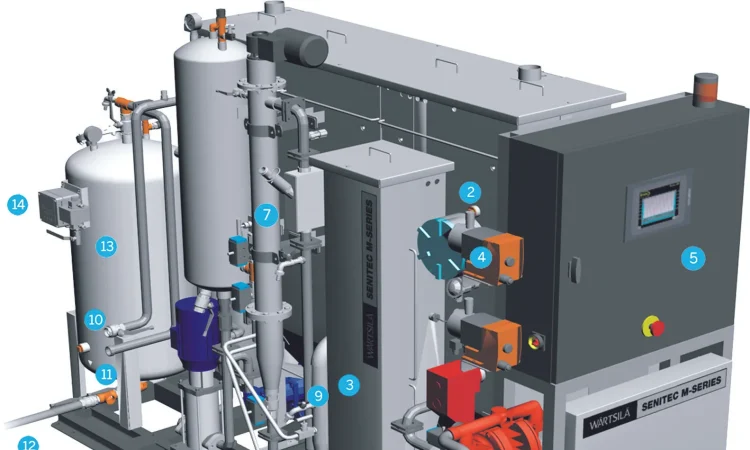
Compressed air is a plant’s fourth utility, but it quietly creates an environmental obligation. Every compressor produces condensate, a mix of water, oil, and particulates, that can’t be dumped down a drain without treatment. Oil/Water Separators bridge the gap between day‑to‑day operations and environmental compliance in air systems, turning problematic condensate into dischargeable water and a small volume of recoverable oil. This guide explains how separators work, the regulations that shape their adoption, practical ways to protect equipment while meeting standards, compliant disposal practices, and why the right solution pays off for sustainability and the bottom line.
How oil/water separators function in industrial air systems
Where the oily water comes from
Condensate forms anywhere compressed air cools—aftercoolers, receivers, filters, and dryers. In lubricated compressors, a fine mist of compressor oil travels with the water vapor and aerosols through the air stream. When the air cools, that mixture condenses into liquid.
Automatic drains—ideally zero-loss types—collect this oily condensate and route it to an oil/water separator, where the two fluids are separated so that clean water can be safely discharged and oil can be captured for proper disposal.
For a deeper look at how oil/water separation technology supports efficient, environmentally compliant air systems, visit https://pneutech.com/.
Core separation stages
While models vary, most industrial condensate separators use a staged approach:
- Pre-separation and depressurization: Incoming condensate is depressurized to prevent aerosol carryover and allow large droplets to settle.
- Gravity/coalescing chamber: Oleophilic (oil‑loving) media attract and grow oil droplets. As droplets coalesce, they rise and are skimmed into an oil reservoir.
- Polishing media: Activated carbon, organoclay, or proprietary resins adsorb dissolved or finely emulsified hydrocarbons to push residual oil content down to local discharge limits.
- Final check and discharge: Treated water exits to a sanitary sewer connection: separated oil is decanted to a waste container for proper handling.
Good units keep pressure drop out of the air system (everything happens at atmospheric pressure) and are sized to the compressor room’s total condensate load.
The emulsions wildcard
Not all condensate behaves the same. Mineral and PAO lubricants typically separate readily. Some synthetic lubricants, especially polyglycols (PAGs) and certain esters, form tight emulsions that bypass simple gravity separation. In these cases, look for separators designed for emulsified condensate with specialized media or emulsion‑splitting stages, and verify performance data for your specific lubricant.
Sizing and validation
- Size to total cfm, humidity, and dryer type, not just nameplate horsepower. A hot, humid summer can double condensate volume compared with winter.
- Ask for third‑party oil‑in‑water performance data (e.g., methods based on n‑hexane extractable material). Discharge targets often range from <15 mg/L to <100 mg/L depending on local rules.
- Ensure compatible inlet accessories: reliable zero‑loss drains, strainers to keep rust/scale from clogging media, and equalization tubing where required.
A correctly specified separator becomes invisible in daily operations, quietly treating every drop without babysitting.
Role of regulations driving adoption of separator technology
Environmental compliance in air systems is shaped by a patchwork of federal, state, and local rules. The common thread: it’s unlawful to discharge oily condensate to the environment or a storm drain, and most municipalities restrict what enters the sanitary sewer.
Key drivers in the U.S.
- Clean Water Act and the “sheen rule” (40 CFR 110): Prohibits discharges that cause a visible sheen or sludge on surface waters. Even a small amount of oil can violate this.
- Local POTW (Publicly Owned Treatment Works) ordinances: Set numeric oil and grease limits for sanitary sewer discharge, commonly 15–100 mg/L, plus prohibitions on hazardous constituents and pH out of range.
- Used Oil Management Standards (40 CFR 279): Govern on‑site storage, labeling, and off‑site transport of separated oil.
- Spill Prevention, Control, and Countermeasure (SPCC) rules (40 CFR 112): Facilities with qualifying oil storage may need an SPCC plan addressing secondary containment and procedures, condensate handling is often referenced.
Why separators are the default solution
Without treatment, condensate typically contains hundreds to thousands of mg/L of oil, well above most discharge limits. Hauling all condensate off‑site as hazardous or oily waste is legal but expensive and carbon intensive. Oil/water separators reduce oil to within local sewer limits so the water can be discharged to a sanitary sewer, while a small volume of concentrated oil is handled under used‑oil rules. Regulators favor this hierarchy because it prevents illicit discharges and reduces waste at the source.
Facilities that document separator performance, discharge pathways, and maintenance find audits smoother and fines avoidable.
Protecting equipment while meeting environmental standards
Compliance and reliability go hand in hand. Poor condensate management hurts both.
Equipment protection in practice
- Dry, clean air: Coalescing filters last longer when they’re not flooded. Proper drains and separators prevent re‑entrainment of oil and water.
- Corrosion control: Liquid water in receivers and piping accelerates rust, fouls valves, and contaminates instruments. Getting condensate out quickly, and treating it correctly, keeps the system healthy.
- Energy savings: Cracked‑open manual drains bleed compressed air 24/7. Upgrading to automatic zero‑loss drains feeding a separator eliminates air loss and lowers compressor run time.
Operational discipline that supports compliance
- Standardize drains at every low point and after every cooling step: route all lines to the separator. Missed drip legs are a common compliance gap.
- Label the sanitary sewer discharge point and cap any nearby floor drains that lead to storm systems to prevent mistakes.
- Periodically sample separator effluent, especially after lubricant changes or major maintenance, to confirm you’re within local limits.
The payoff is fewer nuisance shutdowns, cleaner downstream air, and documented adherence to environmental requirements.
Disposal practices aligned with compliance requirements
A separator is only as compliant as the practices around it. Clear procedures keep the plant, and the environment, out of trouble.
Handle separated streams correctly
- Treated water: Discharge only to a permitted sanitary sewer connection. Never to a storm drain or outdoors. Keep a simple map showing the approved connection point for training and audits.
- Collected oil: Store in a closed, compatible container labeled “Used Oil.” Maintain secondary containment as needed. Arrange pickups with a licensed used‑oil recycler and keep shipping records/manifests.
- Spent media and filters: Many polishing media are non‑hazardous when spent, but characterization is facility‑specific. Keep supplier SDS and, if required, run a waste determination (e.g., TCLP) to classify before disposal.
Maintenance and documentation
- Change media on schedule or when differential indicators call for it. Saturated media won’t meet discharge limits.
- Inspect drains weekly for function: a stuck float can flood a filter housing in hours.
- Log volumes: Estimate condensate treated and oil removed. These records support sustainability reporting and demonstrate control to inspectors.
- Train staff: Short toolbox talks covering what goes where, who to call for pickups, and what not to do (no mop buckets or solvents into the separator) prevent accidental violations.
When in doubt, consult the local sewer authority. A quick phone call up front is cheaper than a notice of violation later.




